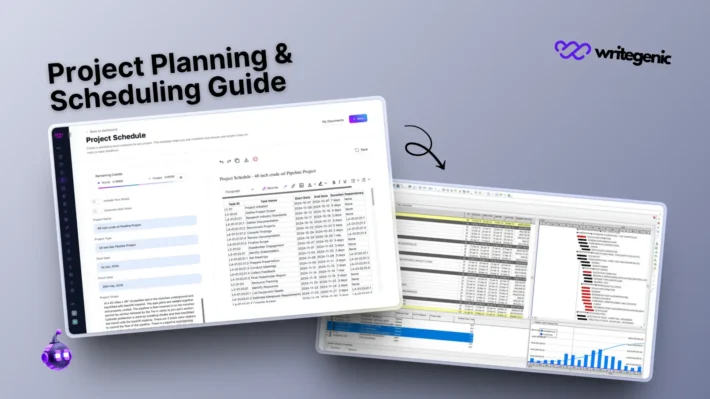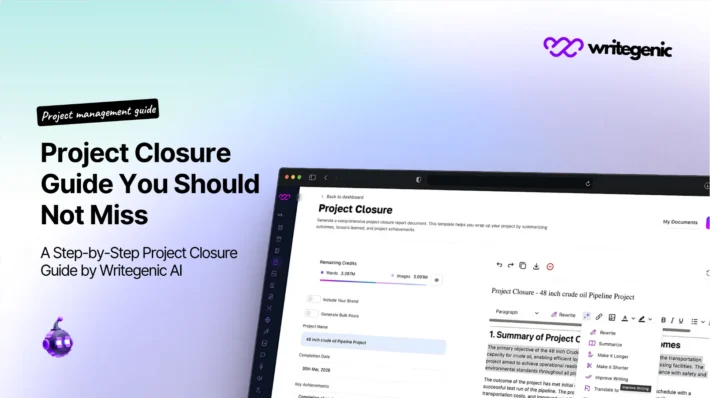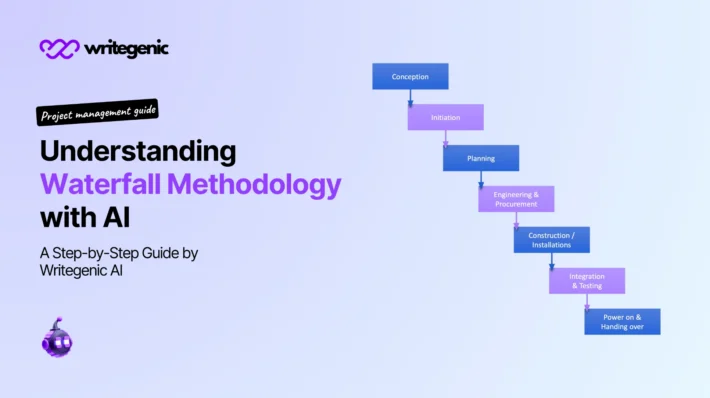How to Write a Project Scope using AI
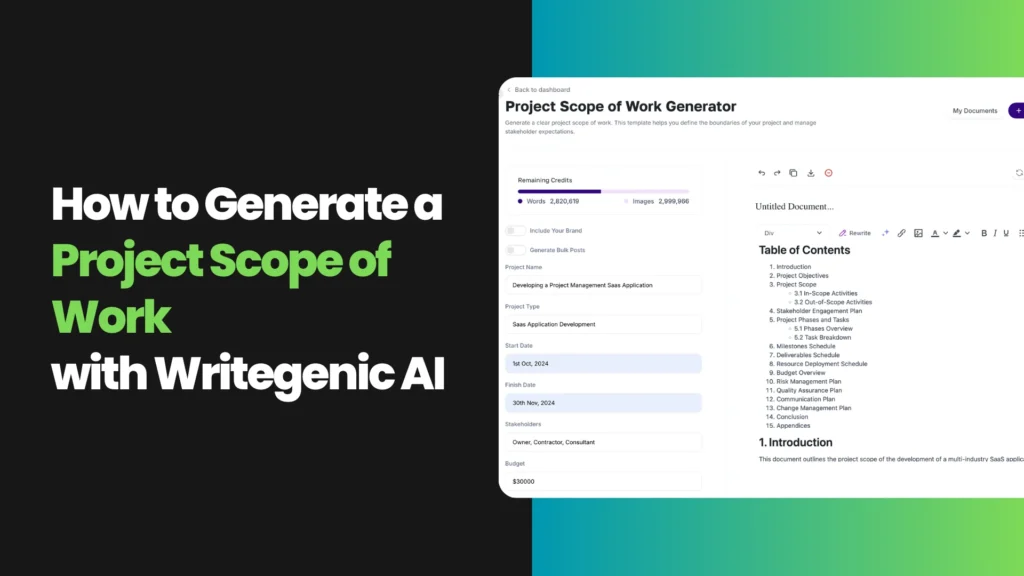
This guide revolves around a study on how to write a project scope for any project or work. It is quite important to note that stakeholder expectation management forms the core of the successful completion of any project. It all begins with a well-defined project scope of work.
WriteGenic AI will show how to easily write a project scope using an AI-powered document template – the “Scope of Work Generator.” This process helps guide one in using an effective template, its benefits, best practices, and some frequently asked questions.
The AI-powered Scope of Work Generator has been designed to assist in developing a comprehensive scope of work for any project, by breaking down all the critical components involved, like project type, objectives, stakeholders, budget, and key milestones.
What is the Project Scope or Scope of Work in General?
Before jumping on to the main topic of how to write a project scope, let’s first discover what the project scope or in other words the scope of work is. The project scope or simply a scope of work is a document describing the required work for a project or any task by giving specific details of tasks to be undertaken, deliverables, timelines, and who does what. This brings boundaries or scope definition, clears expectations, and offers a yardstick against which scope creep can be prevented.
More importantly, a clear SoW (Scope of Work) ensures that project execution goes ahead accordingly with proper coordination, increases resource utilization, and allows for good risk management. It is hence vital and becomes crucial for the success of the project.
Importance of Project Scope of Work Document
The Project Scope of Work is an essential document to carry out any project with successful completion.
It is, to some extent, a formal agreement amongst all the parties of the project to keep all parties on the same page regarding deliverables, timelines, and responsibilities. Here are some key reasons why a Project Scope of Work document is needed:

- Clear Communication and Expectations
The Scope of work is clear communication to all stakeholders involved in the project, including the client, contractors, project managers, and team members. It points out what is covered within the scope of deliverables and what is not covered, hence diminishing a lot of misunderstandings. It prohibits the emergence of useless disputes for things that were expected but unspoken, thus avoiding scope creep.
- Prevents Scope Creep
One of the major risks taken on any project is scope creep that is, when the project grows from its original goals without additional time or resources.
The well-written SoW (Scope of work) clearly describes the boundaries of the project, preventing unapproved changes that can easily derail the timeline, budget, or quality of deliverables. When changes in scope need to be made, the scope of work provides a framework for how those changes should be managed, via change orders.
- Alignment with Stakeholders
With the SoW (scope of work) stipulating objectives, deliverables required, and expectations, it ensures that all stakeholders are clients, project team members, or third-party vendors-are aligned right from the beginning. This will foster collaboration, wherein everyone is working toward the same goals, and the responsibilities are clear.
- Facilitates Planning and Resource Allocation
For a scope of work, the project planning document helps to develop a comprehensive project plan in terms of activity breakdowns, timelines, and resource requirements.
It assists the project manager in allocating resources while trying to factor in any potential conditions that may result in bottlenecks within the implementation of the project.
This scope of work ensures that timelines are realistic and that all the necessary resources, human, financial, and technical, are available.
- Reduces Risk
A Scope of work that is detailed reduces the chances of disputes between parties by putting into record all parameters of the project.
Since responsibilities, deadlines, and what is intended to be achieved for the project are outlined, the scope of work acts as a reference point should there be any anomaly in the execution of the project.
Such proactive steps allow the identification of risks early enough and the possibility of implementing their mitigation strategies.
- Provides a Baseline for Performance Measurement
Scope of work can be used to ensure that the measurement of project progress and success is based upon established baselines.
At the close of the project, it will be constructive to compare actual performance against outlined objectives, deliverables, and timelines in this document to ensure ease of tracking whether or not the project schedule and budget are on course to meet the agreed quality of deliverables.
- Formalizes Client and Contractor Agreement
The scope of work in external projects is a binding agreement between the client and the contractor or service provider. This will help both parties agree on the scope of work, deliverables, timelines, and costs.
The only way any deviations can be done in terms of scope is upon a formal change request. This is to ensure that no party will be surprised later during the project.
Types of Information a Project Scope of Work Document Should Provide
To better understand “How to write a project scope”, you must learn about the types of information that should be provided in a scope of work document. A full scope of work document contains several very important sections that outline the purpose of the project, its scope, timeline, deliverables, and so on. Utilizing an AI Writer can streamline this process by helping generate well-structured scope documents efficiently. Below is a list of the critical information that should be provided in the project scope of work:
- Project Overview
While establishing a project scope management, an overview of a project is very important which further clarifies the statement of how to write a project scope. The project overview provides some background about the project, its purposes, objectives, and goals. This section is essentially an introductory part that provides an overview of the context to all stakeholders.
Example:
The aim of the project is to design a mobile application through which customers can place orders for groceries online and get delivered at their doorstep. This project shall enhance the presence of the client on the web while providing customers with hassle-free shopping smoothly.
- Project Objectives and Goals
Project objectives and goals as it is obvious from the name define the major objectives of the projects that are important when it comes to scheduling a project. The other factor is defining the main goals of the project so that we do not face a drag of dates away from the project completion dates. These have to be specific, measurable, achievable, relevant, and time-bound in nature-SMART.
Example:
The project will be able to reduce order processing time by 20%, improve customer satisfaction by 15%, and implement the application within 6 months.
- Project Deliverables
Specify and mention the tangible or intangible output of the project. Each deliverable should be described in detail, along with its associated deadlines.
Examples:
IT: The prototype MVP shall be delivered at the end of the second quarter of the SaaS application.
Construction: An HVAC system to be delivered in order to final works of false ceiling works.
Oil & Gas: A Butterfly valve has be be delivered and connected to the pipeline.
- Scope of Work
This section provides the exact scope of the work included and what is excluded from the scope when we write a project scope statement. The work to be done is then elaborated on, detailing what shall be carried out in these works.
Example:
This would encompass developing the front-end Interface and back-end database features of the SaaS application. furthermore, integrating a payment gateway, and eventually creating an amiable interface. Anything out of this scope: Marketing of the app after its launch.
- Key Milestones and Timeline
Establish major milestones along with their respective deadlines. This enables stakeholders to track the progress of the work at the critical stages of the project.
Example:
IT: To get the Client and consultant Approval of MVP design and wireframes by September 15th.
Construction: Design and Engineering deliverable approvals by September 15th.
Oil & Gas: Butterfly valve shall be installed by September 15th.
- Budget and Costs
Describe the budget, stating the costs for each phase or component in detail. This section ensures transparency about financial commitments.
Example:
IT: The estimated total budget for the project of the SaaS app is US$ 1 Million, while for development alone, US$400,000, for testing and debugging- US$300,000, and US$300,000 is meant for post-launch maintenance.
Construction: The estimated budget of a 2 storey house in London is £800,000, the design costs £50,000, the material costs around £550,000 while the labor cost is £200,000.
Oil & Gas: The estimated budget for a 4 km oil pipeline installation is US$ 4 Millions, the design engineering costs around US$ 800,000 while the material costs around US$2.1 Millions and Labor & Equipment costs around US$ 1 Million.
- Stakeholders and Responsibilities
List all the significant stakeholders involved in the project, including their roles and responsibilities. This helps ensure that different responsibilities are duly considered.
Example:
Client: Corporate Company or Government body (e.g. London Council), Project Manager: David John, Development Team: XYZ Tech Solutions, Marketing Team: GHI Marketing Agency.
- Project Assumptions
Mention any assumptions that have been made at the outset of the project. These assumptions are those factors that are taken to be true for project planning purposes.
Example:
Assumption 1: The customer and design consultant will provide a draft MVP write-up for the SaaS application no later than September 1st.
Assumption 2: There will be internet connectivity at every place where the application shall be used.
- Constraints
Find out whether any form of limitation exists, which may impact the process of project completion and may be budgetary, time, or resource problems.
Example:
The project must be completed within 6 months as the product launch date is fixed.
- Change Control Process
Define how changes to the scope will be managed, ensuring that any alterations are documented, reviewed, and approved before implementation.
Example:
Any modifications in the project scope shall be proposed through a request for change form and approved by main stakeholders like the project manager and by the client.
- Success Criteria and Performance Metrics
Should specify the criteria showing the project’s success: Measures that will be taken to follow the performance relevance of the project outcomes.
Example:
In this particular project, success implies on-target-date launch of the SaaS application, which should be free of critical bugs after A-B testing and rated 90% by customers within the first three months of operation..”
A Project Scope of Work provides a clear, detailed road map to the execution of the project, and it is key. It is a contract between stakeholders that stops scope creep, ensures alignment, and helps manage risk.
A Scope of work will set the basis upon which the project management function can be effectively executed by providing the objectives, deliverables, timelines, budget, and all that is key to the project. You can learn more about project management by visiting Progressgenic’s website.
Let’s dive into how to use WriteGenic AI’s Project Scope of Work Generator effectively.
Step-by-Step Guide to Using WriteGenic AI’s Project Scope of Work Generator
Step 1: Open Project Scope of Work Generator template
Option 1 – Dashboard Search Bar:
To quickly locate the “Project Scope of Work Generator” template, use the search bar at the top of the WriteGenic AI’s dashboard. Type “Project Scope of Work,” and there it will be displayed.
Option 2 – Go to AI Writer:
Alternatively, navigate to the left navigation pane, click on “AI Writer,” and select the “Project Management” group of templates. You will come to the “Project Scope of Work Generator” template.

Best Practices in Defining a Project Scope of Work
Understanding how to write a project scope is the key here. To get the most out of the Project Scope of Work Generator, here are the best practices that should be followed:
- Be Specific: The more specific the inputs provided, such as stakeholders and objectives, the more accurate and effective the scope of work generated will be.
- Review and Refine: Once a scope is generated, review it to make sure all major elements are included, and update any section as needed to match your project’s unique needs.
- Engage Stakeholders: Share the draft scope early in the process with significant stakeholders to ensure alignment and take in any necessary input before finalization of the document.
- Set Realistic Expectations: Include in the scope those things that are within the bounds of realistic expectations to avoid scope creep once the actual execution of the project is performed. If necessary, state what shall not be included.
Step 2: Enter Essential Information
Once the template is open, you’ll be prompted to fill in key information about your project. Must read this section for a better understanding of how to write a project scope:
- Project Name:
The first information you have to add is the name of the project. This should be a brief yet descriptive title that gives stakeholders a quick understanding of the project.
- Project Type:
Specify the type of project you’re working on, such as “Construction,” “Web Development,” “IT,” “Oil and Gas,” etc. This allows the AI to tailor the scope of work to the specific needs and challenges of that industry.
- Start Date and Finish Date:
Input the project’s expected start and end dates. Defining these clearly will help align all team members on deadlines and expectations.
- Stakeholders:
Mention key stakeholders involved in the project, separated by commas. Examples include clients, project managers, contractors, and councils. Having a clear list of stakeholders ensures that the SoW accounts for all key players in decision-making and resource allocation.
- Budget:
Enter the budget allocated for the project (e.g., $1.2 Million). A defined budget sets financial expectations for stakeholders and ensures all resources are planned accordingly.
- Project Objectives:
An overview of the major deliverables and objectives of the project: It is a very important section in that it helps guide the scope of the work and ensures that every activity exists for the realization of these objectives.
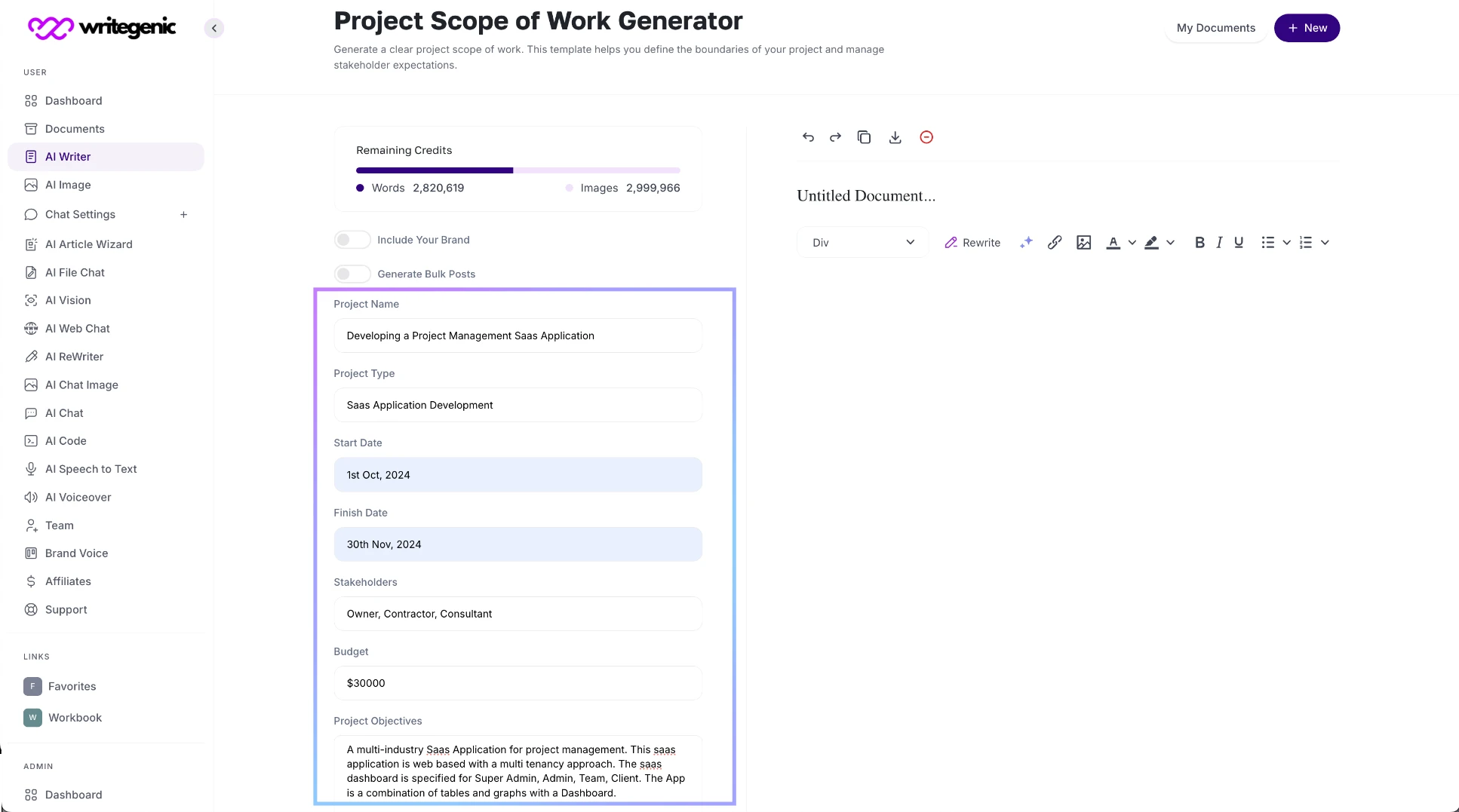
Step 3: Select the Appropriate Options
In this step, you’ll customize the content based on tone, creativity, and language preferences.
- Language: Use the dropdown menu to choose the desired language for your Project scope of work. WriteGenic AI supports multiple languages, ensuring that the content is created in the language that best suits your project needs.
- Maximum Length: Define the maximum length for your project scope of work. You can choose a word limit of up to 3,000 words, ensuring that the document provides enough detail without being overwhelming.
- Creativity Level: Select the appropriate level of creativity for your report:
- Economic: Basic and straightforward content.
- Average: Moderately creative with some level of customization.
- Good: High-quality and creative content.
- Premium: Maximum creativity for in-depth and engaging content.
- The tone of Voice: Select the tone that best fits the nature of your project. For a formal document like the project scope of work, a Professional tone is recommended. Other tones available include:
- Funny: “Add a dash of humor to brighten up your message.”
- Casual: “Keep it light, friendly, and easygoing.”
- Excited: “Spark enthusiasm and get everyone pumped up!”
- Witty: “Smart, sharp, and always one step ahead.”
- Sarcastic: “Because sometimes, you need to say it with an edge.”
- Bold: “Make a statement that demands attention.”
- Dramatic: “Turn up the intensity for maximum impact.”
- Feminine: “Graceful, elegant, and sophisticated in every word.”
- Masculine: “Strong, bold, and authoritative with every sentence.”
- Secretive: “Whisper your message with an air of mystery.”
Step 4: Generate the scope of the work document
Once all the information is filled in, simply click the Generate button, and WriteGenic AI will automatically create your customized Project Scope of Work.
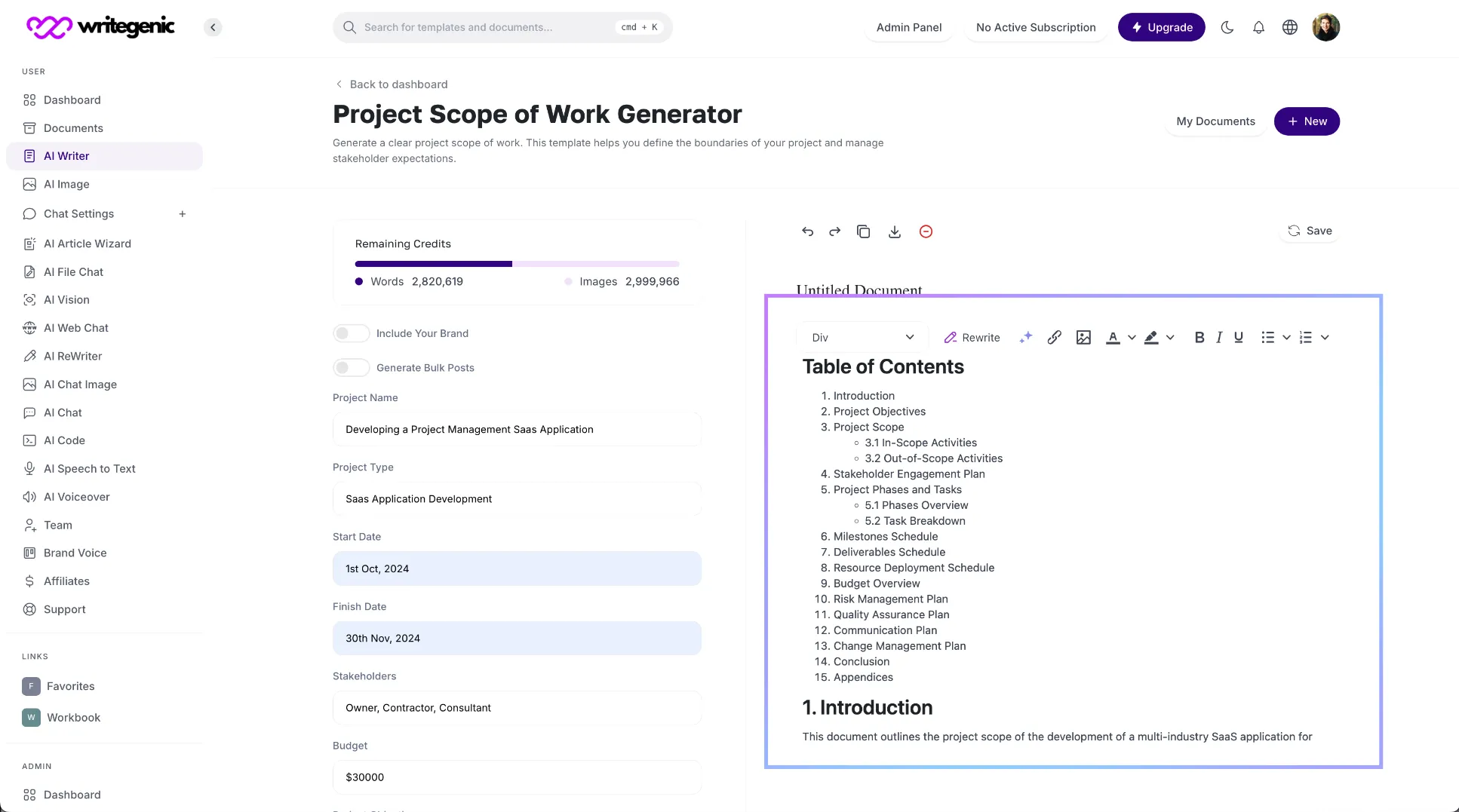
These were the easiest possible steps on how to write a project scope of work with the power of AI using the Writegenic AI tool.
Benefits of Using WriteGenic AI’s Project Scope of Work Generator
WriteGenic AI’s Project Scope of Work Generator has several key benefits:
- Time Efficiency: It saves you hours of manual work while generating project scopes. You can use this time for another critical work of the project.
- Clarity and Consistency: The template makes certain that all major project information is captured but presented clearly and in a standardized format to minimize misunderstandings.
- Personalization: The tool customizes the scope for your industry, budget, objectives, and stakeholders to ensure that the document completely meets your requirements.
- Accuracy: AI ensures that whatever content is created is not only accurate but concise, clear, and free from errors.
- Alignment of Stakeholders: A clearly defined scope of work sets the expectations for all stakeholders, hence promoting smooth project execution.
- Scalability: The template can also be used for very small projects, large-scale projects, or enterprise-wide projects because it is scalable to suit your needs for the project.
FAQs Related to the Project Scope of Work Generator
1. How can I modify the generated Project Scope of Work?
You can easily modify the scope of work by adjusting the project name, type, objectives, and any other details before or after generating the content.
2. Is the generated scope customizable for different industries?
Yes, the Project Scope of Work Generator is flexible and can be tailored to various industries like IT, construction, web development, and more.
3. Does WriteGenic AI support multiple languages for the scope of work?
Absolutely. You can select from a range of languages in the dropdown menu, ensuring that the scope of work is generated in your preferred language.
4. How about a Statement of Work for some other type of project?
Just fill in the new information of project name, stakeholders, and objectives, then generate a new scope of work for each project.
5. How long does it take to develop the scope of work?
When everything has been filled, it generates a complete professional Project Scope of Work within just a few seconds, thus saving a lot of time.
Final Thoughts
The above guide which shows how to write a project scope is your handbook whenever you are going to write any type of project scope for any industry you work in. The Project Scope of Work Generator by WriteGenic AI is an intelligent, time-saving solution for any organization or project manager to articulate comprehensive professional scopes of work with a minimum level of effort.
Automating the development of documents ensures consistency, clarity, and accuracy of the document and easily sustains the expectations of stakeholders while keeping the project on course.
